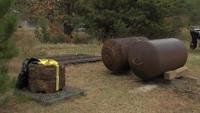CAPE HENLOPEN STATE PARK, Del. - Artillery from World War Two is not a rare sight in Cape Henlopen State Park, home of Fort Miles. What is rare is finding that artillery after a hurricane blows away the layers of sand that kept it buried for decades.
After Hurricane Hermine brought powerful winds to Delmarva, maintenance crews at the park discovered two 400 pound mine cases and two thousand-pound weights used with those mines.
"We got a call from our maintenance staff saying "Hey, we found some big hunks of metal, can you come take a look and see what these are?" recalled Sean Carrow, Interpretive Program Manager of the Fort Miles Historical Area.
They soon realized the five-foot-long, three-foot-wide canisters were used during the war as mines to protect Delaware's coastline from Nazi boats. The mines could hold 25 cubic feet of TNT. One of the mines was hollowed out, but crews could not tell if the second one was, so they called a bomb squad from Dover Air Force Base to determine if the case could still detonate. When they realized it was safe, they moved the artifacts offshore so they could be restored. The mine weights were discovered up a pathway. Carrow's not sure why this is, but suspects the weights were used to cover a nearby gun battery with a tarp years ago, and overtime, it was covered with sand.
The mine cases they discovered were M-2 mines. Once restored, Carrow says they plan on displaying them next to the M-3 and M-4 mines in Battery 519 at Fort Miles. He says the mines are a way for them to preserve history, and inform many people about the First State's involvement in the Second World War.
"They think when they have the Pacific, what's going on over in Europe...nothing in between," he says. "They think we're kind of away from it all, when really [the war] was at our backdoor. This will tie in that connection for folks to say this was a lot closer than most people realize."
The M2 mines' presence was doubly confirmed after employees realized it matched paintings by a soldier who served at Fort Miles, Howard Schroeder. Schroeder's paintings depicted the Fort Miles mine operations. Carrow says that discovery was noteworthy.
"We were able to tie them all together, not just for us and Fort Miles, but what was going on globally during the war," he said.
The mine cases and the weights are being restored in Maryland. Carrow hopes to have them restored and on display by next summer.
For more information on WWII operations in Delaware, visit the Fort Miles Historical Association.





